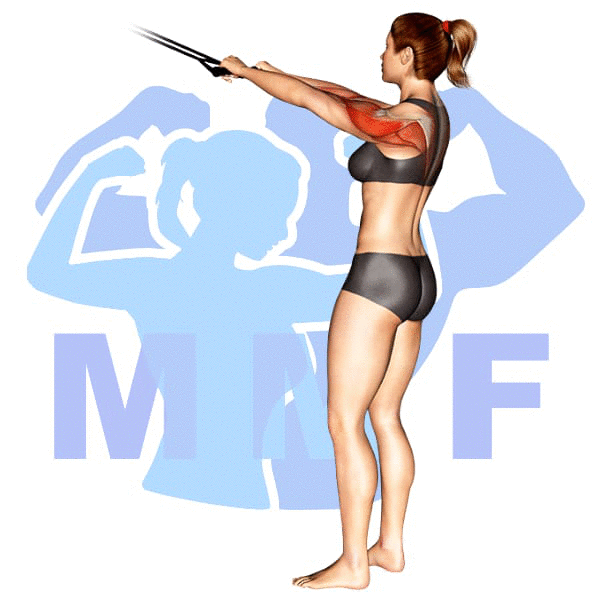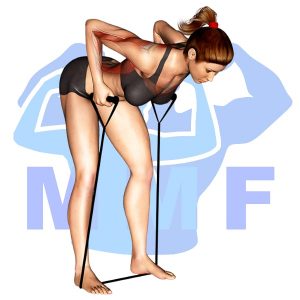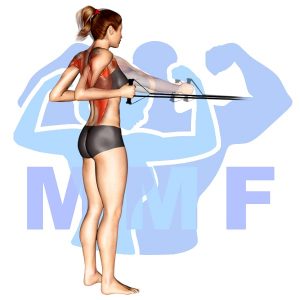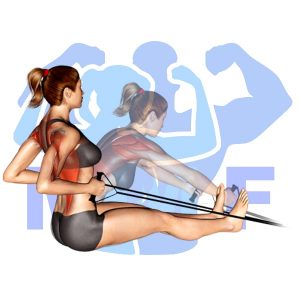Do you struggle with chronic neck and shoulder pain? Does it feel like no matter what stretches or exercises you try, nothing seems to relieve the tension? You’re not alone. Many of us experience pain and discomfort in these areas due to poor posture, excessive screen time, and stress. But don’t worry, there’s a simple solution that may be just what you need: resistance band face pulls. In this post, we’ll explore the benefits of this exercise and how it can help alleviate your pain and improve your overall posture.
Resistance Band Face Pulls Summary
- Primary Muscles: Deltoid – Posterior
- Secondary Muscles: Brachialis, Brachioradialis, Infraspinatus, Rhomboids, Teres Minor, Trapezius – Lower, and Trapezius – Middle
- Equipment: Resistance band and door anchor
- Mechanics Type: Compound
- Force: Pull
- Utility: Basic or Auxiliary

Resistance Band Face Pulls Instructions
- Attach the resistance bands to your anchor point slightly higher than your face
- Grab both handles while facing the anchor point.
- Step back with your arms straight in front of your face until the bands are tight
- Next, pull the band handles back to beside your face and keep your elbows back.
- You want to squeeze the back or your deltoids and traps.
- Then slowly release the tension in your back and return to the starting position.
- Repeat these face pulls for 8-12 reps.
Video Tutorial
Resistance Band Face Pulls Muscles
Target (Agonist)
Synergists
- Brachialis
- Brachioradialis
- Infraspinatus
- Rhomboids
- Teres Minor
- Trapezius – Lower
- Trapezius – Middle
Dynamic Stabilizers
Stabilizers
Antagonist Stabilizers

Benefits of Resistance Band Face Pulls
Resistance Band Face Pulls are a great exercise to include in any strength training or fitness routine. This exercise targets the posterior deltoid muscle, which helps to improve shoulder stability and strength. It also helps to reduce the risk of shoulder injuries, which is important for those who are involved in heavy lifting. The resistance band provides an extra challenge to the muscle, allowing for greater results from the exercise. Additionally, this exercise requires little equipment, making it easy to incorporate into any workout plan.
Tips for Performing Resistance Band Face Pulls
If you’d like to attain the optimal outcomes, implement these straightforward tips. Furthermore, if you desire to avert injuries, adhere to these tips.
- Double Up Bands To Help to Increase The Challenge. If you find yourself easily doing 12 or more reps every exercise, then you want to add to the resistance. You can either do this by elongating the band further at the beginning of the move or by attaching more bands. The popular approach is to add additional bands since it is readily repeatable to have a similar resistance on every workout.
- Concentrate On Inhaling And Exhaling. With this and most workouts, breathing is important. You need to be exhaling out during the target muscle flexing and inhaling when the target muscles are expanding.
- Slow Your Exercise Down For Better Gains. By Raising the time under tension, you are engaging your muscles longer, and they will respond by developing toned muscles. You can achieve this without raising the weight by doing slow reps about 4 – 6 seconds flexing and pause then 4 – 6 seconds relaxing.
Benefits and Tips Video
Frequent Mistakes To Avoid
You should stay clear of these standard mistakes to manage great form and reaching your goals. Moreover
- Don’t have unmatched resistance on each side, or you will train both sides with an imbalance.
- Don’t relax your core. Tightening your abs protects your spinal column by maintaining your internal pressure.
- Avoid Using Too Little or Too Much Tension. Not enough, and you will not be adequately using your agonist (target) muscle, excess, and you’ll likely need to cheat. Make certain you can complete between 8-12 reps with good technique.
Find More Resistance Band Exercises Here
Variations and Complementary Exercises
The Resistance Band Face Pull is an effective exercise for strengthening your upper back and shoulder muscles. To get the most out of your workout, you can incorporate variations, complementary, and alternative exercises to work similar muscle groups. Below is a list of exercises that target similar muscles as the Resistance Band Face Pull.
Resistance Band Bent Over Shoulder Rows

Resistance Band Bent Over Shoulder Rows are an excellent complementary or alternative exercise for Resistance Band Face Pulls. This exercise is performed by standing with your feet shoulder-width apart and holding the band with both hands. Then, bend your knees slightly and lean forward from the hips while keeping your back flat. Next, pull the band towards your chest while squeezing your shoulder blades together at the top of the movement and then slowly return to the starting position. This exercise will help strengthen your back muscles, improve posture, and help with shoulder stability.
Resistance Band Bent Over Rows

Resistance Band Bent Over Rows are a complementary or alternative exercise to Resistance Band Face Pulls. This exercise works the posterior deltoids, rhomboids, and trapezius muscles. It helps to strengthen the back, improve posture, and increase overall upper body strength. To perform this exercise, begin by standing with your feet hip-width apart and your knees slightly bent. Hold one end of the resistance band in each hand and hinge forward from the hips until your torso is almost parallel to the floor. Then, pull the bands up towards your chest, squeezing your shoulder blades together at the top of the movement. Slowly lower the bands back to the starting position and repeat.
Resistance Band Bent Over Rear Lateral Raises

Resistance Band Bent Over Rear Lateral Raises is a great complement or alternative exercise to Resistance Band Face Pulls. This exercise works the rear deltoids and upper back muscles, targeting the same muscle groups as face pulls but in a different way. It also offers the benefit of being able to use different angles and movements to target different areas of the muscles. This exercise is great for increasing shoulder stability and mobility, and can be done with any type of resistance band.
Check Out These Top Resistance Band Exercises
Resistance Band Straight Back Seated Rows

Resistance Band Straight Back Seated Rows is a complementary exercise to Resistance Band Face Pulls and can be used as an alternative exercise. This exercise strengthens the muscles in the back, shoulders, and arms, while also engaging the core and helping to improve posture. To perform the exercise, sit with your feet flat on the floor and hold a resistance band in each hand. Then, pulling against the resistance of the bands, row back with your arms and pull your shoulder blades together. Make sure to keep your back straight and your core engaged throughout the exercise. When done correctly, this exercise can help improve strength and stability in your upper body, while also increasing your range of motion.
Resistance Band Standing Rows

Resistance Band Standing Rows is a great complementary or alternative exercise to Resistance Band Face Pulls. This exercise targets the same muscles as Face Pulls, such as the upper back, shoulders, and biceps. Standing Rows involve placing one foot on the band and gripping the band with both hands. The user then pulls the band up to their chest while squeezing their shoulder blades together. This exercise can be done in a variety of positions, such as standing, kneeling, or seated. Resistance Band Standing Rows is a great exercise for toning and strengthening the upper body muscles, making it a great alternative or complementary exercise to Resistance Band Face Pulls.
Resistance Band Seated Rows

Resistance Band Seated Rows are a great complementary exercise to Resistance Band Face Pulls. This exercise works the muscles in your back, as well as your biceps, allowing you to build strength and tone in both areas. To perform this exercise, sit on the ground with your legs extended in front of you and the resistance band around the bottom of your feet. Holding the handles of the band in each hand, pull the band towards your body while keeping your back straight and your core engaged. Slowly release and repeat for desired reps. This exercise is an effective alternative to Resistance Band Face Pulls as it works the same muscle groups while providing an additional challenge.
Find More Back Exercises Here
Opposing Complementary Exercises
In order to maximize the benefits of Resistance Band Face Pulls, it is important to include exercises that target the opposing muscles. This will create balance within the body and help to prevent injury. Below are a list of exercises that use opposing muscle groups to complement Resistance Band Face Pulls.
Lying Cable Fly

The Lying Cable Fly is an excellent complement to the Resistance Band Face Pulls exercise. It works the opposite muscle group, the chest, by having you lie on your back and use a cable machine to press two weighted handles together. This movement stretches the chest muscles while also strengthening them. By working the opposing muscle group of the Resistance Band Face Pulls, the Lying Cable Fly helps to create balance in your upper body strength and flexibility.
Lunge Push Up

The lunge push up is an excellent exercise to pair with the resistance band face pull. This exercise targets the opposing muscle group by working the chest, shoulders, and triceps. It helps to balance out the exercise by engaging the opposing muscle group. The lunge push up involves starting in a plank position and then stepping one foot forward into a lunge, before pushing back up into a plank position. This exercise is great for building strength in the chest, shoulders, and triceps, and for helping to increase overall balance.
Feet Elevated Push Up

Feet Elevated Push Ups are an effective exercise that strengthens the chest, triceps, and shoulders. This exercise is complementary to Resistance Band Face Pulls because they target opposing muscle groups. Feet Elevated Push Ups focus on the pushing muscles while Resistance Band Face Pulls focus on the pulling muscles. By doing both exercises, you can achieve balance in your upper body strength and prevent muscle imbalances. Both exercises are important for overall upper body strength and health.
Transform Your Shoulders with Resistance Band Face Pulls
If you’re looking to transform your shoulders, resistance band face pulls may be just the exercise you need. This exercise targets the rear deltoids, helping to improve posture and prevent injury. By using resistance bands, you can easily adjust the resistance level to fit your needs, making it a great option for both beginners and seasoned athletes. With consistent practice, resistance band face pulls can strengthen and shape your shoulders, leading to improved overall fitness. So, add this exercise to your workout routine to see a transformation in your shoulders.
References: Wikipedia | ExRx.net | PubMed.gov | Comprehensive List of Back Resistance Band Exercises

